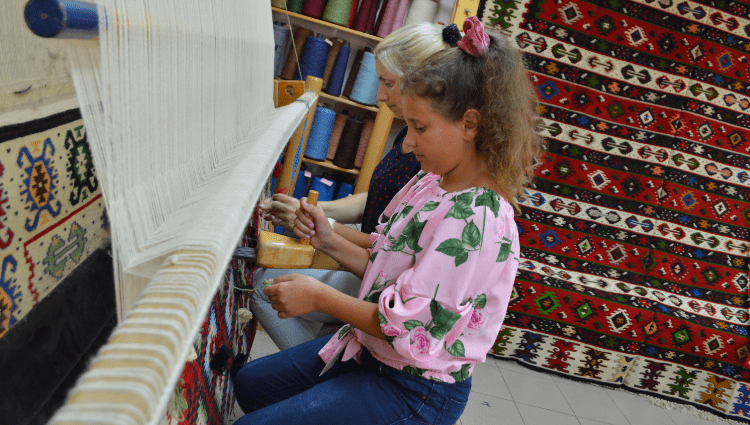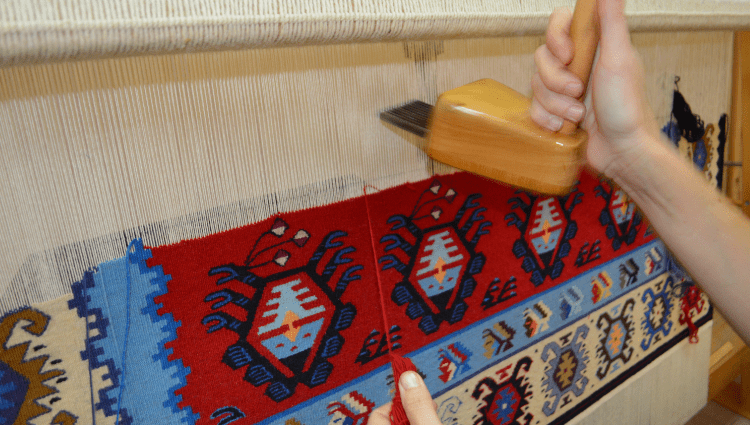
Products that bear a geographical indication of origin owe their special characteristics to the locality in which they are produced. They are the fruit of the traditions crafted over centuries by people from a specific location who have transferred their knowledge and skills across generations. The rugs or kilim produced in Pirot, a town in southeastern Serbia are the gift of such tradition, reflecting the rich cultural and historic legacy of the town’s carpet makers, and the value of this craft, which merits preservation and promotion. That is why, on June 18, 2012, by the decision of the National Committee for Intangible Cultural Heritage of the Republic of Serbia, kilim weaving in Pirot was added to the National List of Intangible Cultural Heritage of the Republic of Serbia under UNESCO protection.
The cooperative of kilim weavers from Pirot, the first organized manufacture of these rugs, was founded 122 years ago, but kilim weaving in Pirot dates from the 9th century AD. With their striking colorful designs, “kilim of Pirot” are renowned the world over for their beauty and quality.
These high-quality rugs gained global recognition in the late 19th and early 20th century winning top awards at the World’s Fairs in Lyon in 1894, and in Liege in 1905. Thereafter, kilim rugs entered the American and British markets. At the Balkan States Exhibition in London in 1907, news reports noted: “in the Queen’s Palace, the beautiful kilims from Pirot celebrated indescribable victory! The English are amazed and in awe,” the Serbian author Žikić Vitković writes in her book Pirot’s Carpet.
After the First World War (1914-1918) the quality standards ─ similar to those governing the current geographical indication ─ for producing the ”kilim of Pirot” were established. In 1925, the Evaluation Board of the Kilim Weaving Cooperative was established. Its role was to ensure that the design, colors and materials used to make kilim rugs met the established quality standards.
In the inter-war years, the Pirot Kilim Weaving Cooperative won over 50 international and domestic awards and prizes, including at the International Exhibition of Art and Technology in Paris in 1937. From the mid-1950s to the mid-1960s kilim rug weaving in Pirot continued to flourish with orders flowing in from Austria, Finland, Japan, Italy, the Netherlands, Switzerland, and West Germany.
Weavers continue to use the best quality wool to make the ”kilim of Pirot.” In the weaving process, the warp (lengthwise yarns) is made from the white wool of the pramenka breed of sheep, now an endangered species, that graze the fields surrounding Pirot. A standard ”kilim of Pirot” (1.4 meters x 2 meters) requires the fleece of at least nine pramenka sheep. Their wool is typically high-quality, long, and easy to process. On average, 300 kilograms of raw wool are needed for 100 kilograms of yarn. This high-quality yarn contributes to the durability of the “kilim of Pirot.”
The ancient concentric designs that characterize the “kilim of Pirot echo those found in ancient Egyptian ceramics, Cyprian vases, and even the kilims of the North American Navaho Indians. This reflects the many and varied influences that have shaped this tradition over the centuries. The symmetrical order of the sharp geometric shapes and patterns gives the “kilim of Pirot” a timelessness. Their graphic motifs consist mainly of abstract, fanciful forms along with natural phenomena and, on occasion, religious symbols. The reds, blues, and greens that dominate their designs are spellbinding.
Serbian weavers have traditionally displayed incredible imagination, introducing designs, shapes and colors that make the “kilim of Pirot” a work of unique beauty that lives on today. Throughout history the “kilim of Pirot” have adorned the palaces and residences of high-ranking officials and places of worship.
The rugs, which are a striking symbol of Serbian folk tradition, are typically produced by women, often under challenging conditions, who learn their craft from their forebears. Weaving kilim rugs is still strenuous work. On average, a modern-day weaver from the Lady’s Heart Cooperative, (the sole authorized user of the geographical indication (GI) “Kilim from Pirot)” works 176 hours (8 hours a day for 22 days of the month) to weave just 0.8m2 of a rug.
Thankfully, the women who weave kilim rugs today have a more secure existence than previous generations. This is critically important in attracting new weavers to the craft and to sustaining production of these eye-catching rugs.
Slavica Ćirić, Director of the Lady`s Heart Cooperative, explains what it takes to be a weaver of “kilim of Pirot” today:
“A woman who wants to be engaged in weaving should have capacities for the craft and be very skillful. She needs a gene for art and must be very focused because for the whole day she is engaged in counting, planning, logics and mathematics. She must also have a capacity to remember, not to make notes, but to remember, because what should be kept in mind all the time cannot be noted down. In addition, and primarily, she must be of good health, because while working, she sits on a low bench next to the loom, with bended legs, and spine upright and hands constantly moving while the tips of the fingers can often be cut like by a razor blade from the sharp threads of the warp made from the pramenka sheep.”
For more than a century, the “kilim of Pirot” have been woven as a single rug on vertical looms, regardless of its size. During weaving, the loom is periodically rotated. This means the weaver never has a complete view of what has been done and has to rely on her memory to visualize the complex designs that are woven into the rug. The weavers adopt a kneeling technique to weave the rugs and the only tool they use is the the tupica, which enables them to beat down the weft yarns. The rugs typically have two sides of equal quality and beauty.
In 2003, the Intellectual Property Office of Serbia recognized “Kilim of Pirot” as a geographical indication (GI). The GI covers kilim rugs, blankets for beds, curtains, draperies and other home textiles. In securing the GI, the kilim rugs and other home textiles made in this historic town, became the intellectual property of the people of Pirot.
With GI certification, only the kilim made by authorized producers may be commercialized as “kilim of Pirot.” The authenticity and quality of the high-quality textiles that bear the GI label is guaranteed. In this way, GI certification boosts consumer confidence; customers can trust that they are buying a genuine “kilim of Pirot.” This, in turn, yields significant benefits for local producers, boosting demand for their high-quality rugs in domestic and export markets and enabling them to defend themselves against substandard copycat rugs.
GI certification is helping to keep domestic traditions alive and is protecting authorized weavers against unauthorized use of the GI label. Legal protection goes beyond deterring piracy; it also represents an obligation on the part of all authorized producers to maintain established quality production standards.
In registering the GI “Kilim of Pirot,” the Intellectual Property Office of Serbia worked with the local weavers to develop a “Book of Specifications,” which outlines the essence of the “kilim of Pirot” and the elements that make it a unique output of ethno-manufacture. These include the way in which it is woven, the quality of the wool used for the warp, the designs specific to the kilim rugs, as well as the colors used for the warp yarn, the obligation to weave on a vertical loom using the kneeling technique, quality control and more.
In the past, the canons of kilim production were dictated by tradition and the unwritten law of the weavers’ craft, resulting in outputs of variable quality. Today, thanks in large part to its GI certification, the “kilim of Pirot” are made to established quality standards.
At present, the Lady’s Heart Cooperative is the sole authorized user of the GI “Kilim of Pirot.” Many former users have lost their status. Anecdotal evidence suggests that this is linked to the high cost of certification and an unwillingness to adhere to the rules governing the preparation, production and sale of GI-certified products. This seems to have also been the experience of producers of other GI-certified products in Serbia. The experiences of producers of GI-certified products around the world, however, suggest that the rules governing the use of a GI can have a positive economic impact on the production of GI-certified products when calibrated to ensure that users are able meet established conditions of use and thereby acquire the right to use the GI. This, however, has not been the case with the production of “kilim of Pirot,” which now relies on funding from both state and private sources.
Although demand for “kilim of Pirot” exceeds the weavers’ capacity to supply them, no new producers with the capacity to qualify as an authorized user of the GI “kilim of Pirot” have emerged since 2009. This is posing a threat to the sustainability of kilim rug production in Pirot and has prompted careful reflection on what needs to be done to revive and sustain the craft.
“The purpose of our work is to preserve kilim weaving in Pirot through the sustainable development and growth of production so that the income realized from sale of kilim can be invested in financing further production, and in ensuring the weavers are adequately rewarded for their work,” says Ćirić, who also underlines the need to organize training workshops for the next generation of weavers.
The GI “Kilim from Pirot” is part of Serbia’s national identity. “Kilim of Pirot” have an excellent reputation and hold great commercial value. In actively promoting these high-quality textiles, the Government will help ensure the weavers of Pirot enjoy greater livelihood security and reap the benefits of their work. It will also help ensure this remarkable craft endures for generations to come. Today, many countries are actively working to develop strategies to harness the economic, social and cultural benefits of products that can qualify for GI protection. Serbia needs to be one of them.
By Vladimir Marić, Director, Intellectual Property Office of the Republic of Serbia
Note: This article by Mr Vladimir Marić was published in the magazine of the World Intellectual Property Organization (WIPO), and you can read it at this link.
Read the entire new issue of WIPO Magazine here.



